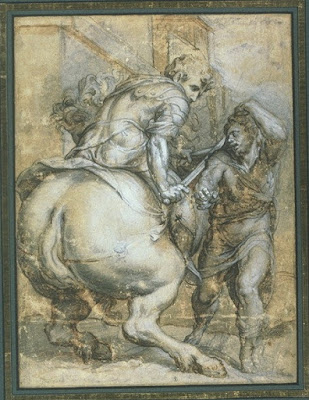 |
| Jacques Bellange Design for Equestrian Statue ca. 1610 drawing Musée du Louvre |
 |
| Jacopo Bellini St George and the Dragon before 1470 drawing on vellum Musée du Louvre |
 |
| follower of Amico Aspertini Sheet of Studies after Antique Reliefs ca. 1530-50 drawing Musée du Louvre |
 |
| Francesco Allegrini Combat on Horseback before 1679 drawing Musée du Louvre |
 |
| Ludwig von Hofmann Reiter an südlicher Küste ca. 1920 oil on canvas Edwin Scharff Museum, Neu Ulm, Germany |
 |
| Sonia Lawson Guardian II 1994 oil on canvas University of Birmingham, West Midlands |
 |
| Nicola Bertuzzi (also called Niccolò Bertucci or l'Anconitano) Battle Scene ca. 1750-70 oil on canvas Pinacoteca Civica di Forlì |
 |
| Paolo Farinati St Martin dividing his Cloak with the Beggar before 1606 drawing Musée du Louvre |
 |
| Cavaliere d'Arpino (Giuseppe Cesari) Head of a Horse before 1640 drawing Musée du Louvre |
 |
| Charles Le Brun Study for Louis XIV on Horseback ca. 1680 drawing Musée du Louvre |
 |
| Giovanni Mauro della Rovere St George and the Dragon before 1640 drawing Musée du Louvre |
 |
| Kazimir Malevich The White Horse 1933 oil on canvas Musée d'Art Moderne de Paris |
 |
| Robin Philipson Men Observed ca. 1980 oil on canvas Victoria Gallery and Museum, Liverpool |
 |
| Jean-François Soiron Military Scene 1793 enamel miniature Musée du Louvre |
 |
| Peter Tillemans Horse with Groom and Hounds ca. 1734 oil on canvas Norfolk Museums |
 |
| George Stubbs Horse frightened by a Lion before 1763 oil on canvas Tate Britain |
 |
| Vincenzo Foppa Woman and Man on Horseback ca. 1480 drawing Musée du Louvre |
Every winter or early spring, Mr. Eakins takes a large class to a suburban bone-boiling establishment, where they dissect horses in the slaughter-house, and in summer they continue the work with studies of the living animal (modelling and painting and studying his movements), which they make at Mr. Fairman Rogers's farm.
"Don't you find this sort of thing repulsive? At least do not some of the pupils dislike it at first?" Mr. Eakins is asked.
"I don't know of anyone who doesn't dislike it," is the reply. "Every fall, for my own part, I feel great reluctance to begin it. It is dirty enough work at the best, as you can see. Yes, we had one student who abstained a year ago, but this year, finding his fellows were getting along faster than himself, he changed his mind and is now dissecting diligently."
"But you find it interesting nevertheless?"
"Intensely," says one of the students, with ardour.
"But the atmosphere of the place, the hideousness of the objects! I can't fancy anything more utterly – utterly – inartistic."
"Well that's true enough. . . . In itself I have no doubt the pupils consider it less pleasant than copying the frieze of the Parthenon. But they are learning the niceties of animal construction, providing against mistakes in drawing animals, and they are, I assure you, enthusiastic over their "hideous" work as any decorator of china at South Kensington could be over hers."
– William C. Brownell, from a profile and interview with painter and educator Thomas Eakins (1844-1916), published in a longer article called The Art Schools of Philadelphia in Scribner's Monthly (September 1879)